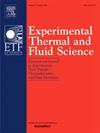窄通道两相流测量印刷电路传感器性能的实验研究
IF 2.8
2区 工程技术
Q2 ENGINEERING, MECHANICAL
Experimental Thermal and Fluid Science
Pub Date : 2025-04-28
DOI:10.1016/j.expthermflusci.2025.111507
引用次数: 0
摘要
印刷电路传感器(PCS)在解决窄通道两相流测量的挑战方面显示出了良好的潜力。传感器几何结构、气泡形状和数据处理算法是影响测量不确定度的关键因素。为了促进PCS在窄信道中的应用,建立了一个可灵活调节信道间隙的实验装置。不同电极间距的传感器用于测量具有精确几何形状的陶瓷片在不同间隙尺寸下的体积分数。详细分析了两相流参数的不确定性和局部空隙率特征。结果表明,局部空泡率测量的不确定度主要受两个无量纲参数的影响:L *(气泡边缘的无量纲距离)和le *(传感器电极间距)。建议将传感器配置为le * =0.6,以便在高空间分辨率下清楚区分气相和液相。建议采用麦克斯韦相关法,结合消噪法求出高精度的平均孔隙率。在无因次泡厚度h∗大于0.8的条件下,大多数情况下所测平均空隙率的相对误差可在±10%以内。投影面积等效气泡直径和周长的准确性取决于气泡直径与传感器电极间距d *的比值。分辨率增强数据得到的气泡直径和周长的相对误差在±20%以内。D∗≤10,且D∗>;10在±10%以内。本文章由计算机程序翻译,如有差异,请以英文原文为准。
Experimental investigation on printed circuit sensor performance for two-phase flow measurement in narrow channels
Printed circuit sensors (PCS) have demonstrated promising potential to tackle the challenges in two-phase flow measurement in narrow channels. Sensor geometric configuration, bubble shape and data processing algorithm are crucial factors influencing the measurement uncertainty. In order to promote the application of PCS in narrow channels, an experimental setup with flexibility to adjust the channel gap has been established. The sensors with a variety of electrode pitches are used to measure the volume fraction of ceramic slice with precisely known geometry in different gap sizes. The local void fraction characteristics, as well as the uncertainties of two-phase flow parameters, are assessed in detail. Results show that the uncertainty of local void fraction measurement is primarily affected by two dimensionless parameters: , which is the dimensionless distance to the bubble edge, and , the dimensionless sensor electrode pitch. It is recommended to configure the sensor with to allow for clear distinction between the gas and liquid phases at high spatial resolution. The Maxwell correlation, combined with the noise elimination method, is recommended to derive high-accuracy average void fraction. The relative error of measured average void fraction can be within ± 10 % for most of the cases, provided that the dimensionless bubble thickness is greater than 0.8. The accuracy of the projected area equivalent bubble diameter and perimeter depends on the ratio of bubble diameter to sensor electrode pitch . The relative error of bubble diameter and perimeter derived from the resolution-enhanced data is mostly within ± 20 % for 1 < and within ± 10 % for .
求助全文
通过发布文献求助,成功后即可免费获取论文全文。
去求助
来源期刊

Experimental Thermal and Fluid Science
工程技术-工程:机械
CiteScore
6.70
自引率
3.10%
发文量
159
审稿时长
34 days
期刊介绍:
Experimental Thermal and Fluid Science provides a forum for research emphasizing experimental work that enhances fundamental understanding of heat transfer, thermodynamics, and fluid mechanics. In addition to the principal areas of research, the journal covers research results in related fields, including combined heat and mass transfer, flows with phase transition, micro- and nano-scale systems, multiphase flow, combustion, radiative transfer, porous media, cryogenics, turbulence, and novel experimental techniques.
 求助内容:
求助内容: 应助结果提醒方式:
应助结果提醒方式:


